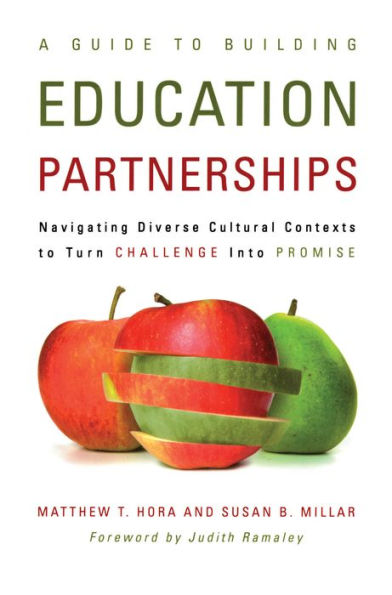
A Guide to Building Education Partnerships: Navigating Diverse Cultural Contexts to Turn Challenge into Promise
230
A Guide to Building Education Partnerships: Navigating Diverse Cultural Contexts to Turn Challenge into Promise
230eBook
Related collections and offers
Overview
Education partnerships are central to – and often a requirement of – most education reform initiatives promoted by state and local governments, by foundations, and by business funders. Many fail for failure to understand the dynamics of their complex relationships.This book provides insights and guidance to enable prospective and existing education partners to develop answers to the questions that are critical to success: Why engage in this partnership? How can you communicate the potential benefits of partnership to motivate teachers, faculty, administrators, and community members? How do you select the best organizational structure and procedures for a partnership? How can you maintain open, deliberative discussion while respecting different histories and cultures? How can you produce compelling evidence that the partnership is worthwhile? Based on their observation of a five-year-long publicly funded partnership, research data, and the literature, the authors identify the principles that they consider critical to answering these questions. The authors do not minimize the differences and complexities inherent in partnership work, because they believe that doing so would be to present coherence and homogeneity where none exists. Instead, they seek to make evident how these principles underlie many different partnership situations. Thus, rather than presenting a package of best practices, or a cookie-cutter approach, this book presents the organizational principles for planning and implementing education partnerships, along with sets of strategies for working through them. The authors present the diagnostic tools for undertaking a deliberate and research-based approach to planning, designing, and managing a partnership. By surfacing participants’ often-differing motivations, and the practices and assumptions they bring to the table, the book provides the foundation for developing a constructive relationship. In scope, the book extends beyond school-university partnerships to include schools’ collaboration with state and local governments, nonprofit organizations, and the business sector.

Product Details
| ISBN-13: | 9781000979343 |
|---|---|
| Publisher: | Taylor & Francis |
| Publication date: | 07/03/2023 |
| Sold by: | Barnes & Noble |
| Format: | eBook |
| Pages: | 230 |
| File size: | 782 KB |
About the Author
Matthew T. Hora is an Associate Researcher at the Wisconsin Center for Educational Research, University of Wisconsin-Madison, where he is currently conducting research on the psychological, cultural and organizational factors influencing teaching in Institutions of Higher Education. Matthew received his Masters in Applied Anthropology from the University of Maryland, College Park after several years experience in organic agriculture and food systems research. He has spent the past seven years working in program evaluation, specializing in assessing the effects of pedagogical reforms in the science, technology, engineering, and mathematics (STEM) fields at the tertiary level.
Susan B. Millar , an anthropologist by training, is director of the education research challenge area of the Morgridge Institute for Research, and a senior scientist in the UW–Madison Wisconsin Center of Education Research. In her work with the Morgridge Institute for Research, she leads a team that is developing online interactive computer games and other learning resources designed to help youth and adults learn core science and engineering concepts in the biomedical disciplines.
Judith A. Ramaley is President of Winona State University. Prior to coming to Minnesota, Dr. Ramaley held a presidential professorship in biomedical sciences at the University of Maine and was a Fellow of the Margaret Chase Smith Center for Public Policy. She also completed a residency as a Visiting Senior Scientist at the National Academy of Sciences.From 2001 to 2004, Dr. Ramaley was Assistant Director, Education and Human Resources Directorate (EHR) at the National Science Foundation (NSF). Prior to joining NSF, Dr. Ramaley was president and professor of biology at the University of Vermont. Dr. Ramaley has a special interest in higher education reform and has played a significant role in designing regional alliances to promote educational cooperation. She has contributed to national discussions about the changing nature of work and the workforce. She plays a national role in the exploration of civic responsibility and the role of higher education in promoting good citizenship. She also has published extensively on educational reform; science, technology, engineering, and mathematics education; and the leadership of organizational change.
Table of Contents
Introduction. The Challenge and Promise of Education Partnerships The Nature of Education Partnerships Working in a Partnership. New Tasks and Challenges Methodology. Understanding the Underlying Mechanisms of Partnership The Five Principles of Partnership How To Use This Book Part One. Getting Ready for Partnership 1 Shall We Dance? Convening a Pre-Partnership Planning Group Convening a Pre-Partnership Planning Group A Final Word on Pre-Partnership Planning 2 Sizing Up Organizational Aspirations and Attributes Problems, Goals, and Objectives Motivations Capacity and Resources Autonomy and Interdependence 3 Understanding Cultural Dynamics Avoiding the Common-Culture Myth Focusing On Cultural Dynamics Within Organizations Agenda Items for Your Pre-Partnership Meeting 4 Crossing Organizational and Cultural Boundaries Why Boundary Crossing is Important Characteristics of Boundary Crossing Agenda Items for Your Pre-Partnership Planning Meeting Part Two. Designing A Partnership 5 Types of Organizational Structures for Partnership Three Main Partnership Structures Selecting a Partnership Type 6 Administration and Leadership Governance Selecting Leaders Other Administrative Functions 7 Effective communication systems Working With Existing Systems Creating a Progressive Partnership Communication System Part Three Implementing Partnerships 8 Designing the work Understand the Task Environment Select Leverage Points Build Bridges to All Levels of the Local Partner Organization 9 Developing and Managing Working Groups Guidelines for All Working Groups Additional Guidelines for Collaborative Working Groups 10 The Key Roles of Trust and Managing Conflict Dynamics of Trust in Partnerships Strategies for Developing Trust Managing Conflict in Education Partnerships Epilogue Appendix A. Methodology References Glossary Index
